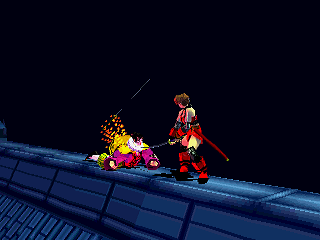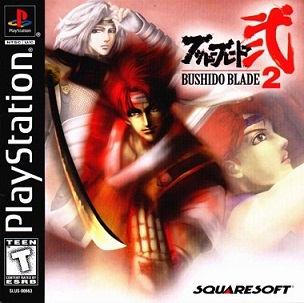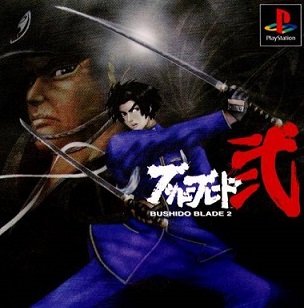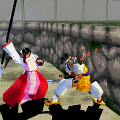- Bushido Blade
- Bushido Blade 2
To refine a blade is to strengthen it by removing unwanted materials. This is the approach Bushido Blade 2 takes towards its core mechanics, setting itself apart from the great majority of fighting game sequels.
There are now two attack buttons rather than three, and each parries the other; if both fighters are in the same stance, for instance, and one swings his sword upwards, the other would parry it by swinging downwards. Blocking a Normal with a Reverse (or vice-versa) in this way is called Perfect Defense and provides the defender with a slight advantage. An attack can also be stopped with one of the same type, but this results in a stagger that leaves the defender open. As this renders the old blocking move redundant, the Square button is now used to cycle between your three stances. Crouching is performed with R2 alone, and you can jump or throw dirt or subweapon from there. With this leaner control scheme, Bushido Blade 2‘s internal logic is more clearly defined and easier to grasp than its predecessor’s. It also results in a more defensive game. Avoiding attacks is easier, too, with swifter sidesteps and backdashes, which probably explains why the backroll maneuver was eliminated. In exchange, you can now launch into a lunging counterattack after your weapon is hit while in a neutral position; this can catch the opponent offguard or spell your death if anticipated.
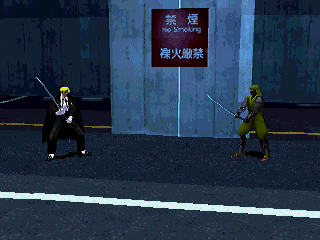
The weapons available to the main cast have gone from eight to six; the Sledgehammer, Saber and Rapier have been eliminated and a counterpoint to the Naginata, the Yari, has been added. The first two were likely judged redundant on top of the Broadsword and Long Sword, while the new Two-Swords stance allows one to stab with the second sword as you would with the Rapier. In fact, one character, Highwayman, uses a Rapier as his subweapon. There is another new stance, in which a warrior keeps their weapon sheathed until the right moment, then draws it and strikes in one swift movement. Both the Two-Swords and Sheathed stances are reserved for a handful of characters. A more ambivalent change is that it’s no longer possible to cripple your opponent’s legs. Considering that few attacks hit low anymore, this is no surprise. Nonetheless, it was one of the first game’s coolest feature and a major part of its strategic aspect. While Bushido Blade 2 may be a more refined game in many aspects, the elimination of leg wounds and the Sledgehammer save its predecessor from obsolescence.
On the other hand, the roster goes from seven characters to twenty-two (once everyone is unlocked), with a wide variety of designs, from the traditionally cool to the comical and extravagant. They’re divided into enemy clans, the Narukagami (which includes most of the original cast) and the Shainto, with a few independents who side with one or the other for reasons of their own. Katze, the gun-toting mercenary, now has a female counterpart, making for a fun matchup.
There are many new attack chains and special moves, always depending on the combination of character and weapon you choose. They include “throws”, which must be performed at close range and kill your opponent unless escaped. A warrior might slide around his enemy and slice his throat, or kick him to the ground and cut him down mercilessly. Setting them up can be risky, but they’re always satisfying to pull off. Each character possesses a unique special move, and there’s a much greater variety to the subweapons now; among the coolest are a frog, which leave certain characters paralyzed with fear, and a fierce war cry which temporarily stuns the opponent but can cause its user to cough, leaving him vulnerable instead.
The stages are quite a bit more diverse and there are more reminders that, despite the theme, this series takes place in modern times; between the Japanese forests and traditional dojos, there’s an underground parking lot with a No Smoking sign and a concrete bridge with metal railings. Some areas feature cliffs or other high places from which one can fall or be pushed to one’s death. The coolest level has to be the narrow Castle Rooftop, which restricts the gameplay to two dimensions. If the first game’s visual theme was snow, this time it’s darkness, as the story takes place over the course of a single night.
The large cast and high number of battle areas probably explain why the graphics are actually worse this time around; the character models aren’t as detailed, and the draw distance is quite low, but the visuals remain decent overall.
There’s a new Group Battle mode in which each player picks a school and battles the other. You must pick a different weapon for each character, which can lead to some interesting matchups. As those matches are fought for honor, wooden weapons are used; rather than kill, one must score points, like in a real-world competition. The Story mode has been significantly expanded. Most stages have you fight a series of ninjas before you get to face a playable character or boss. There are two distinct paths through the game depending on whether you play as an Urukagami or Shainto, and the specific stages and opponents in either vary a bit depending on the character.
The most interesting idea, though, is that at two points during the story, an ally will meet up with the protagonist and become playable for the following stage. If you manage to keep the ally alive, you will unlock them in every play mode; if not, your main character will come running to take their place. This adds tension to these stages, though on the other hand, it also means it takes a certain amount of patience to unlock everything, as a single playthrough can get pretty long for a fighting game. It doesn’t help that the final boss battles revolve around annoying gimmicks, particularly when palying as a Shainto. The whole Bushido aspect has been put aside, so you can fight however you want to without consequences.
The narrative deals with a war between two secret schools of assassins located on a small island, the Narukagami and the Shainto. The conflict started 800 years prior, when two large samurai clans from the mainland began fighting. Though both the Kagami and Sue were affiliated with the losing side, the Kagami switched allegiances and attacked the Sue, but a few survived and swore revenge. In order to protect themselves, the Kagami eventually founded the Narukagami school, and the Sue followed with the Shainto. They have been fighting in the shadows ever since. With the Narukagami undermanned following the internal strife a year before, the Shainto launches a full-scale attack on their dojo, the Meikyokan, in order to retrieve the sacred sword Yugiri and destroy their enemy.
The plot itself is more developed than before, and it’s especially rewarding to see how everyone relates to one another and fits into the overarching events. Unfortunately, their conversations have been fully dubbed in English, and the voice acting is about as competent as you’d expect of a PS1 game, making it hard to take the more dramatic scenes seriously. There are a few attempts at comic relief, usually through somewhat embarassing gaijin characters, but the tone remains serious most of the time.
The Slash mode must be unlocked by finishing Story mode with a few characters this time around, but is otherwise essentially the same, and there’s a new story-less single player mode if you just want to fight the CPU. You can still fight in a first-person view, and it’s still as useless as before.
The music was handled by lesser-known Square composer Ryuji Sasai (Treasure Hunter G, Final Fantasy Mystic Quest); it has more of a hard rock edge, but still uses shamisen and the like to give it a Japanese feel. Like before, it plays during the VS modes while Story mode is mostly quiet, and the ending credits theme is once again the best song in the game.
Though Bushido Blade 2 and its predecessor share a common spirit, the changes in gameplay from one game to the next inevitably created dissatisfaction among some fans. It would have been interesting to see whether a third episode might have attempted to bring together the best of both games, or taken another direction altogether. Unfortunately, though sales of either games weren’t exactly bad, they weren’t quite up to Square’s multi-million standards.
Sadly, shortly after the game’ release, Square disassociated itself from Lightweight and sold off the 40% shares it held in the company. Like Tobal, Bushido Blade ended after only two entries, both of which are available on the Playstation Network store.
Before long, those same shares were bought by Genki, a company whose founders, like several Light Weight employees, had once worked for Sega’s AM2 studio. Their first game under this new arrangement was the early PS2 title Kengo: Way of the Bushido. Though director Kunihito Nakata was not involved, it was perceived as a spiritual sequel to Bushido Blade and received as a failure. Two sequels followed on the same console and a final chapter was released for the Xbox 360. In truth, they are different enough from Bushido Blade that they should be viewed as an entirely distinct series.
Characters
Narukagami
Kannuki
A powerhouse from Okinawa, his entire village was massacred on Hanzaki’s orders in the first game for reasons that were never revealed. Following this tragedy, he moved to New York where he worked as a bodyguard before returning to Japan at Mikado’s request. Can use throws with every weapon, but his strength allows him to handle the Broadsword with particular ease. His subweapon is the Iron Fan, which is too heavy to be parried effectively or thrown very far.
Mikado
A maiden at Takara Shrine, where the last descendant of the Kagami family is hidden, she plays a central role in both games. Though fast rather than strong, she is best with large weapons like the Naginata. Her subweapon is the Aikuchi, a weak pocketknife that can be thrown two at a time.
Utsusemi
The eldest of the Narukagami, Utsusemi is a master swordsman, Tatsumi’s father and the former Kage chief. He has trained many at the Meikyokan and is respected by friend and foe alike. He can use the Two-Swords stance. In the first game, his subweapon was a weak knife, but in the second he can throw his second sword, like all Two-Swords users.
Tatsumi
This young student of the Narukagami got involved in the events of the first game when he stumbled upon the existence of the Kage. He left the dojo afterwards to refine his skills by challenging other schools and returned at Mikado’s request. His birth hides a predictable plot twist. He’s changed a lot between the games; in BB1 he was best with Saber or Sledgehammer and had no subweapon, in BB2 he masters the Nodachi and can use the Two-Sword stance.
Red Shadow
A kunoichi (or female ninja) of Russian origins, she actually belongs to the legendary Koga clan, but is totally dedicated to Utsusemi. She runs significantly faster than most characters and has a great running attack. She’s best with the Long Sword, with which she has the Two Swords stance. Throws shuriken in the first game, her second sword in the second.
Black Lotus / Highwayman
An Irishman who came to Japan to live according to the Bushido. Though he maintains a deep respect for Utsusemi, the events of the first game caused him to leave the Narukagami and join the Shainto under a new identity in search of the true way of the samurai. A Rapier master in the first game, he still uses one as a sub weapon and can combine it with a Long Sword in the Two-Sword stance.
Matsumushi
A carefree type styled after the ronin of old, he belongs to no particular school but is an acquaintance of Kannuki’s. He becomes involved despite himself after saving a mysterious girl near a shrine. He’d rather take it easy than fight, but he’s good with a Katana and possesses moves than cover a good distance, along with the Two-Swords stance.
Suminagashi
A large foreigner of undisclosed origins, he joined the Meikyokan out of gratitude for Mikado, who helped him out when he arrived in Japan. He speaks slowly and uses simple words, reflecting his basic Japanese in the original version. The Broadsword is a good match for his strength and slow speed, and he throws a weak knife.
Nightstalker
A Koga ninja who trained alongside Red Shadow. He has had a crush on her since those days, but hasn’t had a chance to talk to her since. He gets involved under her orders. He wears a red uniform similar to what she wore in the first game. He’s similarly swift and deadly, but favors the katana and throws shuriken.
Sazanka
One of the unplayable bosses in the first game, where he wielded a unique weapon ressembling a spear with blades on both ends. He can use the Nodachi with the speed and ease of a Katana. He wears strange clothes that make him look like a clown and maintains a joyous attitude, but his ambition is to become the Meikyokan Dojo Master.
Tsubame
Another unplayable boss from the first game, she can be unlocked through Slash mode in the second, where she trades her sword for a large rifle (though she only fires one bullet at a time) and her armor for a sexy outfit. Nothing is known about her. Only playable in VS mode.
Shainto
Gengoro Narazu
A subleader of the Shainto, he is actually older than Utsusemi, though it doesn’t show. He’s a strong but swift swordfighter and excels with a Katana or Broadsword. He can also use the Sheathed stance. His only weakness is that his subweapon’s a weak throwing knife, but it hardly matters.
Kaun
Gengoro’s adopted son, he is cold and distant, and only fights out of obligation. Among the Shainto, he is regarded as their finest swordsman. Like his father, he favors the Katana and can also use the Sheated stance. His special moves allow him to cover a long distance in a short time, usually following a feint. His subweapon is the Tokko, a two-bladed throwing knife than can kill.
Jo Kotomura
A teenage girl from a family of fish merchants, she believes in the Shainto’s teachings with the faith of the newly converted and is eager to prove herself. She’s quick but physically weak and fights best with a Long Sword.
Chihiro
The heir to the Shainto clan. Though only a young boy, he grows tired of hiding away in the dojo and joins the battle hoping for excitement. He hides a frog in his kimono, which he can throw at opponents to shock them before finishing them off.
Isohachi
The Elder of the Shainto and, judging by his old-fashioned Japanese Navy uniform, a decorated war veteran. He wants to prove that he’s still got it despite his age. He’s best with the Nodachi. His specialty is a war cry that can stun opponents, however it sometime throws him into a coughing fit that leaves him vulnerable.
Utamaru
A brash loudmouth type who comes on to every woman he meets, he maintains a one-way rivalry with Kaun, who surpasses him in everything but couldn’t care less. He’s an agile fighter who excels with a Long Sword, but his subweapon is pretty useless.
Hongou
Trained by Isohachi, he first shows up as one of the secret bosses in the first game, before becoming playable in the second. It seems he has lost a fight to Tatsumi before and wants to settle the score, perhaps implying that Tatsumi’s secret ending to the first game is cannon. He also seems to know Kannuki. Like him, he’s slow, strong and can use throws with any weapon. His subweapon is an handaxe that can deal fatal damage.
Tony Umeda
A funky American who sometimes speak in rhymes. He sports a large afro and appears to be a disco dancer. Though he’s been a Shainto for a long time, he doesn’t hang out at the dojo and no one seems to know him. Despite being treated as comic relief, he’s not a bad character; he runs as fast as the ninjas, and he can use the Sheathed stance with a katana. His subweapon is a pair of boomerangs that come back to him if they miss their target.
Katze
A foreign killer-for-hire who uses a pistol, he can be unlocked through Slash mode in both games. Originally hired by Kage-chief-gone-bad Hanzaki, he shows up on the Shainto side the second time around. Only playable in VS mode.
Bosses / Misc.
Hanzaki
The main boss of the first game, Hanzaki was the Meikyokan dojo master until he was possessed by the Yugiri and his evil actions precipitated his death, though it is hinted that there may be more behind it all.
Kindachi
A mysterious warrior in heavy samurai armor, who appears as the secret final boss in three of the first game’s characters’ stories.
The Tatara Shrine Priest
Final boss of the Shainto path, he teleports whenever he’s hit, but reappears a little closer everytime. He must be stricken before he can get back up.
The Shainto Leader
Final boss of the Narukagami path, he wields heavy armor that makes him invulnerable, safe for one weak spot. He actually says his name before you confront him, but the American pronunciation makes it impossible to understand.
The Kabukis
One can be unlocked for each side in Bushido Blade 2. They do not feature in the story in any way.

